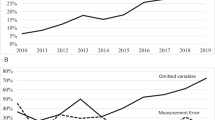Abstract
The adjacent Malmquist productivity index is compared to the more recently suggested base period Malmquist productivity index. The two index approaches are evaluated with respect to base period dependency, the circular test, and with respect to a set of additional classical index tests. In addition it is shown that the base period index is independent of base period if and only if the marginal rate of substitution of inputs is independent of time. Finally, the adjacent and the base period indexes are put through a Monte Carlo (bootstrap) test to see if they yield similar results when applied to a panel of Swedish pharmacy data.
Similar content being viewed by others
References
Balk, B. M. and R. Althin. (1996). “A New, Transitive Productivity Index.” The Journal of Productivity Analysis 7, 19–27.
Berg, S. A., F. R. Førsund and E. S. Jansen. (1992). “Malmquist Indices of Productivity Growth during the Deregulation of Norwegian Banking, 1980–89.” Scandinavian Journal of Economics (Supplement), 211–228.
Caves, D. W., L. R. Christensen and W. E. Diewert. (1982). “The Economic Theory of Index Numbers and the Measurement of Input, Output, and Productivity.” Econometrica. 50(6), 1393–1414.
Diewert, W. E. (1987). “Index Numbers.” In J. Eatwell, M. Milgate and P. Newman (eds.), The New Palgrave; A Dictionary of Economics. London: The Macmillan Press.
Diewert, W. E. (1992). “Fisher Ideal Output, Input, and Productivity Indexes Revisited.” The Journal of Productivity Analysis 3, 211–248.
Eichhorn, W. and J. Voeller. (1976). Theory of the Price Index. Berlin: Springer-Verlag.
Efron, B. (1979). “Bootstrap Methods: Another Look at the Jackknife.” Annals of Statistics 7, 1–26.
Farrell, M. J. (1957). “The Measurement of Productive Efficiency.” Journal of the Royal Statistical Society. Ser. A: 120, 253–281.
Fisher, I. (1911). Purchasing Power of Money. New-York.
Fisher, I. (1922). The Making of Index Numbers: A Study of Their Varieties, Tests, and Reliability. Boston: Houghton Mifflin Company.
Frisch, R. (1936). “Annual Survey of General Economic Theory: The Problem of Index Numbers.” Econometrica 4, 1–38.
Färe, R., S. Grosskopf and C. A. K. Lovell. (1985). The Measurement of Efficiency of Production. Boston: Kluwer-Nijhoff Publishing.
Färe, R. (1988). Fundamentals of Production Theory. Berlin: Springer-Verlag.
Färe, R., S. Grosskopf, B. Lindgren and P. Roos. (1989). “Productivity Developments in Swedish Hospitals: A Malmquist Output Index Approach.” Discussion Paper 89-3, Department of Economics, Southern Illinois University, Carbondale. Forthcoming in A. Charnes, W. W. Cooper, A. Y. Lewin and L. M. Seiford (eds.), Kluwer Academic Publishers.
Färe, R., S. Grosskopf, B. Lindgren and P. Roos. (1992). “Productivity Changes in Swedish Pharmacies 1980–1989: A Non-Parametric Approach.” The Journal of Productivity Analysis 3, 85–101.
Färe, R. (1993). “The Malmquist Productivity Index and the Circular Test.” Mimeo, at CORE.
Hjalmarsson, L. (1991). “Teorier och metoder i forskning om produktivitet och effektivitet med tillämpningar på produktionen av tjänster.” In: Hur mäta produktivitet?. Expertrapport nr. 1 till produktivitetsdelegationen.
Malmquist, S. (1953). “Index Numbers and Indifference Surfaces.” Trabajos de Estatistica 4, 209–242.
Manly, B. F. J. (1991). Randomization and Monte Carlo Methods in Biology. London: Chapman and Hall.
Noreen, E. W. (1989). Computer Intensive Methods for Testing Hypotheses. New-York: John Wiley & Sons.
Samuelson, P. A. and S. Swamy. (1974). “Invariant Economic Index Numbers and Canonical Duality: Survey and Synthesis.” The American Economic Review 66(4), 566–593.
Shephard, R. W. (1953). Cost and Production Functions. Princeton: Princeton University Press.
Shephard, R. W. (1970), Theory of Cost and Production Functions. Princeton: Princeton University Press.
Törnqvist, L. (1936), “The Bank of Finland's Consumption Price Index.” Bank of Finland Monthly Bulletin 10, 1–8.
Westergaard, H. (1890). Die Grundzüge der Theorie der Statistik. Jena: Gustav Fischer.
Author information
Authors and Affiliations
Rights and permissions
About this article
Cite this article
Althin, R. Measurement of Productivity Changes: Two Malmquist Index Approaches. Journal of Productivity Analysis 16, 107–128 (2001). https://doi.org/10.1023/A:1011682625976
Issue Date:
DOI: https://doi.org/10.1023/A:1011682625976




